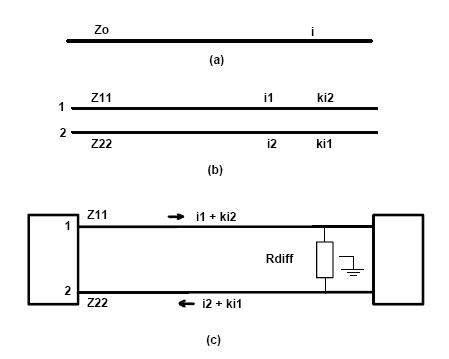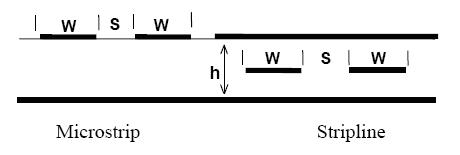
单线
图1(a)演示了一个典型的单根走线。其特征阻抗是Z0,其上流经的电流为i。沿线任意一点的电压为V=Z0*i(根据欧姆定律)。
一般情况,线对:图1(b)演示了一对走线。线1具有特征阻抗Z11,与上文中Z0一致,电流i1。线2具有类似的定义。当我们将线2向线1靠近时,线2上的电流开始以比例常数k耦合到线1上。类似地,线1的电流i1开始以同样的比例常数耦合到线2上。每根走线上任意一点的电压,还是根据欧姆定律,为:
V1 = Z11*i1 + Z11*k*i2 (1)
V2 = Z22*i2 + Z22*k*i1
现在我们定义Z12 = k*Z11以及Z21 = k*Z22。这样,式(1)就可以写成:
V1 = Z11*i1 + Z12*i2 (2)
V2 = Z21*i1 + Z22*i2
这是一对熟悉的联立方程组,我们可以经常在教科书中看到。这个方程组可以推广到任意数量的走线,并且可以用你们中大部分人都熟悉的矩阵形式来表示。
特殊情况,差分对:图1(c)演示了一对差分走线。重写式1:
V1 = Z11*i1 + Z11*k*i2 (1)
V2 = Z22*i2 + Z21*k*i1
现在注意在仔细设计并且是对称的情况下,Z11 = Z22 = Z0,且i2 = -i1这将导致(经过一些变换):
V1 = Z0*i1*(1-k) (3)
V2 = -Z0*i1*(1-k)
注意V1 = -V2,当然,这是我们已经知道的,因为这是一个差分对。
有效(差模)阻抗
电压V1以地为参考。线1的有效阻抗(单独来看,在差分对中叫做“差模”阻抗,通常叫做“单线”阻抗)为电压除以电流,或:
Zodd = V1/i1 = Z0*(1-k)
由上可知,因Z0 = Z11 且 k = Z12/Z11,上式可写成:Zodd = Z11 - Z12这也是一个在许多教科书中都可以看到的公式。
为了防止反射,正确的端接方法是用一个值为Zodd的电阻。类似地,线2的差模阻抗与此相同(在对称差分对的特定情形下)。
差分阻抗
假定在某一瞬间我们将两根走线用电阻端接到地。因为i1 = -i2,所以根本没有电流流经地。也就是说,没有真正的理由把电阻接地。事实上,有人认为,为了将差分信号和地噪声隔离,一定不能将它们接地。因此通常的连接形式如图1(c)中所示,用单个电阻连接线1与线2。电阻的值是线1和线2差模阻抗的和,或:
Zdiff = 2*Z0*(1-k) 或
2*(Z11 - Z12)
这就是为什么你经常看到实际上一个差分对具有大约80Ω的差分阻抗,而每个单线阻抗是50Ω。
计算
知道Zdiff是2*(Z11-Z12)不是很有用,因为Z12的值并不直观。但是,当我们看到Z12与耦合系数k有关,事情就变得清晰了。事实上,耦合系数与我在Brookspeak中关于串扰的专栏[1]中谈到的耦合系数是相同的。国家半导体发布的计算Zdiff的公式[2]已经被广泛接受:
Zdiff = 2*Z0(1-.48*e-.96*S/H) 微带线
Zdiff = 2*Z0(1-.347*e-2.9*S/H) 带状线
其中的术语在图2中定义。Z0为其传统定义[3] 。

图 2 差分阻抗计算中的术语定义
共模阻抗
为了讨论完整起见,共模阻抗与上面略有不同。第一个差别是i1 = i2(没有负号),这样式3就变成:
V1 = Z0*i1*(1+k) (4)
V2 = Z0*i1*(1+k)
并且正如所期望的,V1 = V2。因此单线阻抗是Z0*(1+k)。在共模情况下,两根线的端接电阻均接地,所以流经地的电流为i1+i2且这两个电阻对器件表现为并联。也就是说,共模阻抗是这些电阻的并联组合,或:
Zcommon = (1/2)*Z0*(1+k),或
Zcommon = (1/2)*(Z11 + Z12)
注意,这里差分对的共模阻抗大约为差模阻抗的1/4。






















 1120
1120

 被折叠的 条评论
为什么被折叠?
被折叠的 条评论
为什么被折叠?








